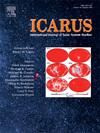Visible spectroscopy of 3 KBOs and 1 Centaur
IF 2.5
2区 物理与天体物理
Q2 ASTRONOMY & ASTROPHYSICS
引用次数: 0
Abstract
Material remaining from the formation of the outer Solar System congregated in the Kuiper Belt. Studying this material has provided key information about the formation of the Solar System, the distribution of planetary materials, and the compositions of different objects. Additional spectra of objects in the Kuiper Belt will provide further insight into Solar System formation and evolution. An important question is whether, and in what quantity, hydrated material formed in the outer Solar System. We address this question here with visible spectra of three Kuiper Belt Objects (KBOs) and one Centaur. We find moderately red spectral slopes for these four bodies, with no clear evidence for the 7000 Å feature due to Fe-rich phyllosilicates. These results extend the overall lack of detection of hydrated materials among KBOs and Centaurs. Although it is clear that hydrated silicates are not common in the outer Solar System, some hydration might be expected, and further observations will continue to refine its prevalence.
3个柯伊伯带天体和1个半人马座天体的可见光谱
外太阳系形成时遗留下来的物质聚集在柯伊伯带。研究这种物质提供了关于太阳系形成、行星物质分布和不同物体组成的关键信息。柯伊伯带天体的额外光谱将提供对太阳系形成和演化的进一步了解。一个重要的问题是,在外太阳系是否形成了水合物质,以及形成了多少水合物质。我们在这里用三个柯伊伯带天体(kbo)和一个半人马天体的可见光谱来解决这个问题。我们在这四个天体中发现了适度的红色光谱斜率,由于富含铁的层状硅酸盐,没有明确的证据表明7000 Å特征。这些结果扩大了在柯伊伯带天体和半人马座天体中探测到水合物质的总体缺失。虽然水合硅酸盐在太阳系外并不常见,但一些水合作用是可以预料到的,进一步的观察将继续完善其普遍性。
本文章由计算机程序翻译,如有差异,请以英文原文为准。
求助全文
约1分钟内获得全文
求助全文
来源期刊

Icarus
地学天文-天文与天体物理
CiteScore
6.30
自引率
18.80%
发文量
356
审稿时长
2-4 weeks
期刊介绍:
Icarus is devoted to the publication of original contributions in the field of Solar System studies. Manuscripts reporting the results of new research - observational, experimental, or theoretical - concerning the astronomy, geology, meteorology, physics, chemistry, biology, and other scientific aspects of our Solar System or extrasolar systems are welcome. The journal generally does not publish papers devoted exclusively to the Sun, the Earth, celestial mechanics, meteoritics, or astrophysics. Icarus does not publish papers that provide "improved" versions of Bode''s law, or other numerical relations, without a sound physical basis. Icarus does not publish meeting announcements or general notices. Reviews, historical papers, and manuscripts describing spacecraft instrumentation may be considered, but only with prior approval of the editor. An entire issue of the journal is occasionally devoted to a single subject, usually arising from a conference on the same topic. The language of publication is English. American or British usage is accepted, but not a mixture of these.
 求助内容:
求助内容: 应助结果提醒方式:
应助结果提醒方式:


